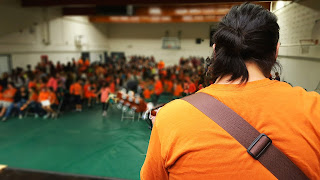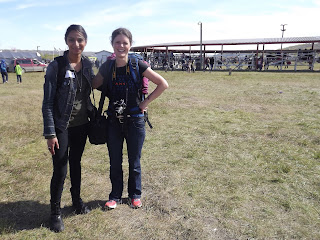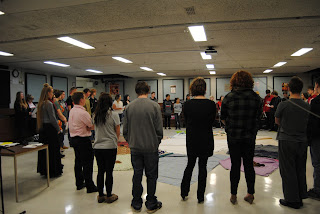Perhaps to get started the editor would ask the question, "What is a Treaty Walk?"
I might reply. A treaty walk is like going to the garden -- back in the days when I lived at home and going to the garden meant fighting my way through Dad's long rows of corn, squash, pumpkin, beans, peas, swiss chard, carrots, beats, and potatoes -- and picking something from the earth. A treaty walk is like taking that good gift from the land and preparing it for my own nourishment or to share with others.
"All well and good," says the editor. "Can you tell me more? How about completing some of these prompts?"
One highlight I've experienced with my Treaty Walk is...
One assumption for me in working with Treaty Education is...
The most important thing for me on my Treaty Walk is...
My most awkward moment Treaty Walking since we last met is...
Yesterday, I tell the editor, I experienced a highlight on my Treaty Walks. We shared an Orange Shirt Gathering at our school. One of my adult students, Michael Cardinal, in Oski-pimohtahtamwak otayisīniwiwaw (they are into their new journey to knowledge) closed our gathering playing Led Zeppelin's "The Rain Song" because the sun will shine after the rain or storm, he told us.
One assumption for me in working in Treaty Education is that it is easy for educators to understand how important it is to show up at events where indigenous peoples are offering us gifts, Treaty gifts of miyowîcêhtowin (getting along together); pimâcihowin (making a living on the land); wîtaskêwin (being one with the land) and wâhkôhtowin (practicing our kinship). For example, bringing students to the Treaty Four Gathering in Fort Qu'Appelle, in the week of September 15 each year, should be easy. I see now, this is an assumption, but it does get easier, I'd like to tell people. Once you've been there once, you'll understand how to come back the next time. But the first thing is to just go, is to show up, as I remember Dr. Shawneen Pete and Dr. Mike Cappello reminding us at the 2014 SAFE conference. Sheena August, Prairie Valley School Division communications officer, and I had great discussions about the importance of experiencing something before understanding. Sheena (we had so much fun being two Sheena's) got right into the spirit of things, working with Arwen to get the tipi pole back in the flap as she had been shown to do earlier, if it slipped out.
The most important thing for me on my Treaty Walks is to remember that Treaty is about relationships, and relationships need opportunity, time, nurturing, sunlight, rain, and wind to grow. Treaty Walking is not a checklist of activities on a bucket list. It is going about regular life, being mindful of the great gifts and opportunities envisioned in the Treaties. I'm thinking about running into Daya Madhur and Claire Krueger at the Treaty Four Gathering, and there they were, going about their lives, huge smiles, cameras slung around their necks, backpacks ready for a day on the land as Treaty people, as Treaty educators.
My most awkward moment since we last met... oh there are so many. It might have been trying to get a good picture of His Excellency David Johnson, Governor General of Canada as he visited Treaty Four Grounds for the first time in his life, and was the first representative of the Queen to return to meet with the crown's treaty partners in 142, since the Treaty was signed. I had to dodge security, media, well-wishers, and handlers. I did get a few with him talking with my friend, Maddie Sanderson. I also helped arrange that my husband, Michael's grade 12 Canadian Studies class was able to witness the nation to nation speeches and meeting, but that wasn't really awkward. Now I'm just bragging. "Well, now I have something to work with," says the editor. "But what about our next episode? Let's do an A-Z brainstorm for Treaty Walks."
Awkward
B
C
D
E
F
G
H
I
J
K
L
M
N
O
P
Q
R
S
T
U
V
W
X
Y
Z




































